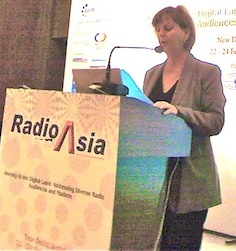At last week’s Radio Asia Conference in Jakarta, Commercial Radio Australia CEO Joan Warner tackled the question, ‘with online around, why does radio technology exist any more?’ There are plenty of reasons that radio exists said Warner, urging delegates to be positive about radio’s future. The case study in Australia, where Radio is outperforming most other media in audience and revenue is a good example. In Australia digital radio is succeeding and has achieved a 10% penetration of the population in around 3 years.
Comparing radio with internet, Warner said costs and bandwidth increases on the internet as the audience increases, but costs of broadcasting free to air radio remain fixed no matter how many people listen. Telco networks go down when too many people try to use them all at once, but radio does not.
Discussing the rise of digital radio in cars, Warner told delegates that getting digital radios into cars is an important next step for the radio industry, because 34% of radio listening in Australia is in cars. Already, many car companies have begun to put digital radios in their Australian models of cars.
In other important research, about half of Australia’s 16-24 year olds say they listen to radio on their phones. For this reason CRA is setting up trials with Telco Operators to test DAB+ chips in phones. They will provide free to air broadcasts, backed up by phone apps.
In the same session Freddy Tulung, Director General of the Communications Ministry told delegates that Indonesia has 43% radio penetration. There is much more to be done to bring radio to the whole country, but there is no shortage of applicants from people who want to set up stations, with 1300 licence applications received by the ministry. Radio has to play its part in educating the Indonesian population, which is surrounded by 10 other countries and crosses three time zones. “Some parts of our society have no access to information,” he said.
Asked about the availability of emergency frequencies to be used by radio stations in times of disaster, he said the ministry had reserved several frequencies that broadcasters could access at short notice in times of disaster.
Nicholas Levitte outlined how his company, Triton Digital, helps broadcasters to take advantage of new trends on the web by providing streaming solutions, as well as monitoring web traffic. “On the internet you can measure 100% of your audience. The information is verifiable, which is important for advertisers. Online radio complements on-air radio,” he said.
Audience research expert Mark Neely, who now works with GfK, outlined the many different methods now available to track audiences in a presentation titled ‘will new radio technology be accountable.’
“There are so many listening choices now for people, so ratings companies have to adapt,” he said, explaining the variety of methods now available to measure radio listening audiences.
People Meters are one new way of measuring audiences, but, because the information is collected in different ways, the results are sometimes different. “Radio’s reach generally goes up with meters,” said Neely, “while TSL goes down.”
Neely explained the various types of people meter on the market, and also outlined other methods of collecting listening data, including online diaries.

